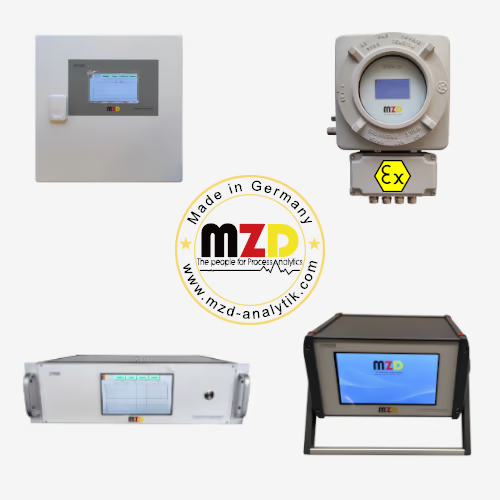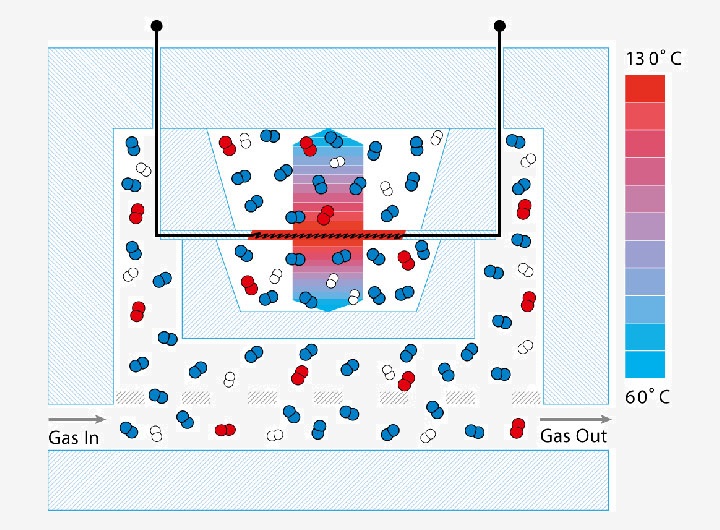
Thermal conductivity analyzer
1. Introduction
The material thermal conductivity of each gas differs, and its thermal conductivity (or thermal conductivity) is related to its molar mass and temperature and has little effect on the gas pressure. When gases with different thermal conductivities are mixed, the thermal conductivity of the mixture depends on the concentration of its components. So the proportion of each component gas can be determined.
The principle of thermal conductivity measurement is particularly applicable when the gases to be measured have significantly different thermal conductivities and one of the following three conditions is fulfilled.
1. the gas mixture contains only two components. For example, the carbon dioxide content in nitrogen or the hydrogen content in nitrogen.
2. the gas mixture contains more than two components, but the concentration of only two components changes.
3. A gas mixture contains more than two components and the background gas contains two or more components but with similar thermal conductivity, which corresponds to two components mixture. For example, when measuring hydrogen or helium in oxygen/nitrogen.
2. Measurement principle
The sample gas flows through the thermal conductivity cell, which is heated to a constant temperature of 60°C and a thermistor above the film to a constant temperature of 130°C. This creates small cavities below and above the film into which the measurement gas can diffuse. The heat loss due to the thermal conductivity of the sample gas is compensated by heating, and the voltage required to maintain a constant temperature of the film is measured for the thermal conductivity of the measured gas.

3. Anti-corrosion protection
Some gases form compounds with moisture that can corrode with the sensor, thus damaging the measurement accuracy and eventually destroying the measurement capability. Therefore, MZD sensors use stainless steel and O-rings made of FPM or FFKM. And a 4µ thick protective coating of halogenated polymer layer is applied to the surface of the measurement sensor. This coating does not affect the excellent measurement performance of the sensing unit and effectively protects the sensor.
To strongly corrossive gas, measuring cell is made from Al2O3 , glass and quartz. It's can be used for high contents of Cl2 , HCl, H2S, SO2, etc.
4. Condensate and dust control
The sensor is protected with a sintered glass of µm pore size, through which gas molecules can pass, while liquid water molecules can not penetrate. In addition the sintered glass protection layer reduces the dependence on the gas flow, so that the sample gas flow can be 10 to 400 L/h through the thermal conductivity cell.
High temperature sensor with thermostat-controlled gas paths up to 180°C can be used for high dew points and/ or to avoid possible salification.
5. Built-in integrated flow meter
Built-in flow measurement with arithmetic compensation by gas composition.
6. Optional NDIR sensor for compensation
The presence of interfering components in the sample gas is an important factor in generating additional error, which is almost negligible for most gases when the concentration is low. Complex gas mixtures can be fully determined by cross-sensitivity modeling and other measurements. Even IR and humidity measurements can be used to compensate for the arithmetic, allowing for an integrated solution for determining homonuclear and rare gases in complex gas mixtures.
7. Built-in multiple gas measurement modes
The instrument has 16 built-in binary gas mixture measurement modes and calibration data, so that different gases and gas mixtures can be measured using the same instrument.
8. Measurement range
Measuring gas | Background Gas | Measurement range | Min. range 1 | Min. range 2 | Gas mixtures |
Hydrogen(H2) | Nitrogen (N2) or air | 0% – 100% | 0% – 0.5% | 98% – 100% | Yes |
Hydrogen(H2) | Argon (Ar) | 0% – 100% | 0% – 0.4% | 99% – 100% | Yes |
Hydrogen(H2) | Helium (He) | 20% – 100% | 20% – 40% | 85% – 100% | |
Hydrogen(H2) | Methane(CH4) | 0% – 100% | 0% – 0.5% | 98% – 100% | |
Hydrogen(H2) | Carbon dioxide (CO2) | 0% – 100% | 0% – 0.5% | 98% – 100% | |
Hydrogen(H2) | Oxygen(O2) | 0% – 100% | 0% – 0.8% | 97% – 100% | |
Carbon dioxide (CO2) | Nitrogen (N2) or air | 0% – 100% | 0% – 3% | 96% – 100% | Yes |
Carbon dioxide (CO2) | Argon (Ar) | 0% – 60% | 0% – 10% | — | Yes |
Argon (Ar) | Oxygen(O2) | 0% – 100% | 0% – 3% | 96% – 100% | Yes |
Argon (Ar) | Carbon dioxide (CO2) | 40% – 100% | — | 80% – 100% | Yes |
Argon (Ar) | Xenon (Xe) | 0% – 100% | 0% – 3% | 99% – 100% | |
Nitrogen (N2) | Argon (Ar) | 0% – 100% | 0% – 3% | 97% – 100% | Yes |
Nitrogen (N2) | Hydrogen(H2) | 0% – 100% | 0% – 2% | 99.5%– 100% | Yes |
Oxygen (O2) | Nitrogen (N2) | 0% – 100% | 0% – 15% | 85% – 100% | Yes |
Oxygen (O2) | Argon(Ar) | 0% – 100% | 0% – 2% | 97% – 100% | Yes |
Oxygen (O2) | Carbon dioxide (CO2) | 0% – 100% | 0% – 3% | 96% – 100% | Yes |
Methane (CH4) | Nitrogen (N2) or air | 0% – 100% | 0% – 2% | 96% – 100% | Yes |
Methane (CH4) | Argon (Ar) | 0% – 100% | 0% – 1.5% | 97% – 100% | Yes |
Neon (Ne) | Argon (Ar) | 0% – 100% | 0% – 1.5% | 99% – 100% | |
Helium (He) | Nitrogen (N2) or air | 0% – 100% | 0% – 0.8% | 97% – 100% | Yes |
Helium (He) | Argon (Ar) | 0% – 100% | 0% – 0.5% | 98% – 100% | Yes |
Krypton (Kr) | Argon (Ar) | 0% – 100% | 0% – 2% | 96% – 100% | |
Deuterium gas (D2) | Nitrogen (N2) or air | 0% – 100% | 0% – 0.7% | 96% – 100% | |
Deuterium gas (D2) | Helium (He) | 0% – 100% | 0% – 5% | 70% – 100% | |
Sulfur hexafluoride (SF6) | Nitrogen (N2) or air | 0% – 100% | 0% – 2% | 96% – 100% | |
Nitrogen Dioxide (NO2) | Nitrogen (N2) or air | 0% – 100% | 0% – 5% | 96% – 100% | |
Extinguishing gas (R125) | Nitrogen (N2) or air | 0% – 100% | 0% – 5% | 98% – 100% |
10. Typical applications
Thermal conductivity gas analyzers are an effective method for measuring a component of two gas mixtures (with very different thermal conductivities). It is mainly used to measure the content of hydrogen (H2), carbon dioxide (CO2), argon (Ar), etc. Some typical applications are listed below.
- Measurement of hydrogen (H2) content in synthesis gas of ammonia plant
- Hydrogen (H2) purity measurement in hydrogenation plants
- Measurement of hydrogen (H2) in pure hydrogen (O2) and hydrogen (H2) in pure oxygen (O2) in the process of hydrogen and oxygen production by electrolysis of water
- Measurement of hydrogen (H2) content in hydrocarbon gases
- Monitoring of hydrogen (H2) and carbon dioxide (CO2) content in hydrogen-cooled generator sets
- Measurement of hydrogen (H2) in chlorine gas (Cl2) in chlorine production processes
- Measurement of carbon dioxide (CO2) content in the combustion flue gas of the furnace cellar
- Argon (Ar) content measurement in air separation units
- Monitoring of pure gas production, e.g. helium (He) in nitrogen (N2), argon (Ar) in oxygen (O2)
- Measurement of sulfur dioxide (SO2) content in sulfuric acid and phosphate fertilizer production processes
Application case list:
No. | Industry | measurement tasks | Measurement | Measurement Range | Carrier gases |
1 | Chemicals | Hydrogen as impurity | H2 | 0-0,5% | Ar, N2, O2 |
2 | Chemicals | Hydrogen production by electrolysis | H2 | O2 | |
3 | Chemicals | Ammonia (NH3) production | H2 | NH2, Air | |
4 | Chemicals | Fertilizer production methanation furnace and ammonia (NH3) converter export | H2 | 50-100% | N2, CH4, NH3, Ar |
5 | Air Separation, Chemicals | Hydrogen purity | H2 | 99-100% | N2, O2, HC, Air, SIH4 |
6 | Air Separation, Chemicals | Argon refining process | H2 | Ar | |
7 | Metallurgy | Annealing furnace H2, N2 anti-oxidation | H2 | N2, ppm O2 | |
8 | Metallurgy | Blast furnace gas | H2 | 0-20% | N2, CO, CO2, H2O |
9 | Metallurgy | Blowing Oxygen Furnace (BOF) | H2 | 0-10% | N2, O2, H2O, O2, CO, CO2, Fuel gas |
10 | Metallurgy | Pig iron for steel plants | H2 | % | |
11 | Metallurgy | Heat treatment H2, N2 | H2 | 0-5% ; 10%; 20% | N2, ppm O2 |
12 | Metallurgy | Protective Gas | H2 | Air, N2 | |
13 | Metallurgy | Hydrogen removal, monitoring of H2 discharge from the metal melt | H2 | N2 | |
14 | Chemical & Pharmaceutical | Quality Inspection | Impurity | Ar | |
15 | Glass production | Flat glass production | H2 | 0-10% | N2 |
16 | Food & Beverage, Medical Technology | Gas Mixing | |||
17 | Semiconductor Industry | Monitoring Process | H2 | 0-8% | Ar |
18 | Power plant | Turbine Generator | H2 | 0-100% | CO2 or Ar |
19 | Power plant | Turbine Generator | Air | 0-100% | CO2 or Ar |
20 | Power plant | Turbine Generator | H2 | 90-100% | Air |
21 | Power plant | Turbine Generator | H2 | 90-100% | Air |
22 | Power plant | Turbine Generator | H2 | Air | |
23 | Nuclear Power | Nuclear energy, monitoring deuterium in the air (D2) | D2 | 0-5% | D2, Air |
24 | Nuclear Power | Nuclear power plant, vacuum dragging reconstructor after condenser | H2 | 0-5% | N2, O2 |
25 | Nuclear Power | Nuclear power plants, hydrogen propagation analysis to avoid flammable atmosphere | H2 | 0-20% | Air |
26 | Petrochemical | Acetone, phenol, isopropylbenzene production | H2 | 50-100% | N2, CH4 |
27 | Petrochemical | H2 production from isocyanate in feed gas | H2 | 0-1Vol% | CO |
28 | Petrochemical | Aromatic lift gas tube, N2 header and regulator hopper | HC, H2 | 0-15% 0-1% | НС |
29 | Petrochemical | Caprolactam production H2 purity | H2 | 70-100% | N2, ppm NH3, ppm CO |
30 | Petrochemical | Hydrocracker unit cycle gas compressor | H2 | 50-100% | Hydrocarbons |
31 | Petrochemical | Hydrocracker make-up gas | H2 | 50-100% | Hydrocarbons |
32 | Petrochemical | Hydrocracker downstream collection point | H2 | 50-100% | Hydrocarbons |
33 | Electrical industry | Welding | H2 | N2 | |
34 | Life Sciences & Medical Applications | Nitrous oxide anesthetic dose N2O | N2O | N2 | |
35 | Automotive, Power Generation, Renewable Energy | Fuel Cell | H2 | O2, N2 |
